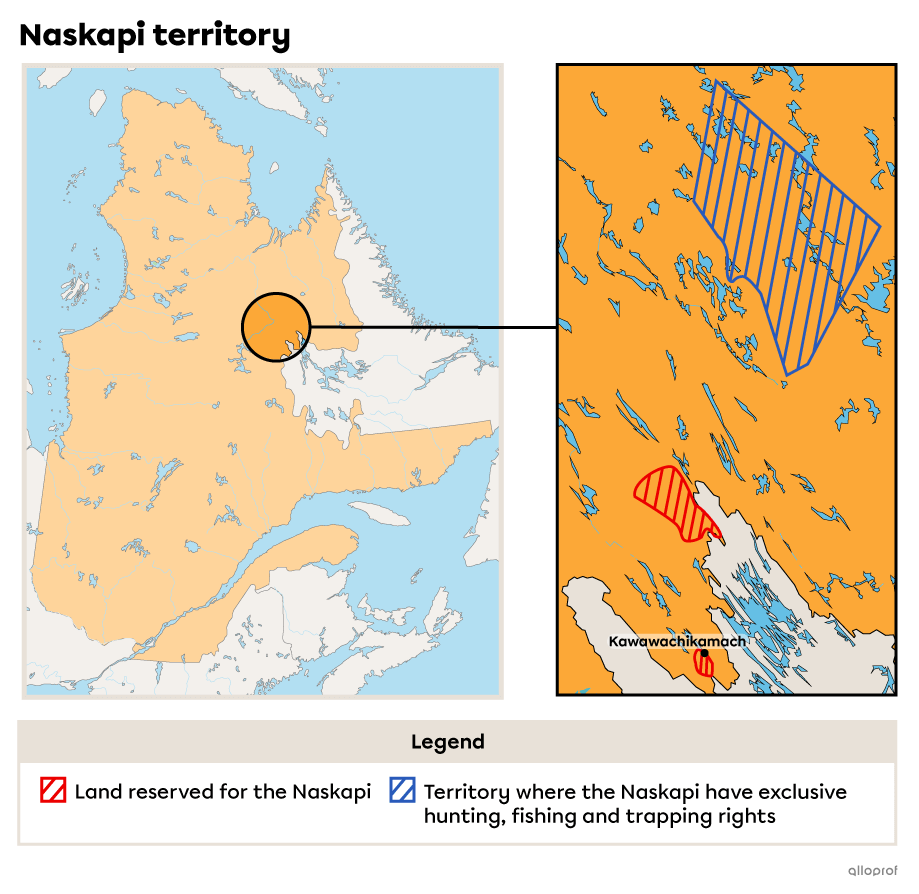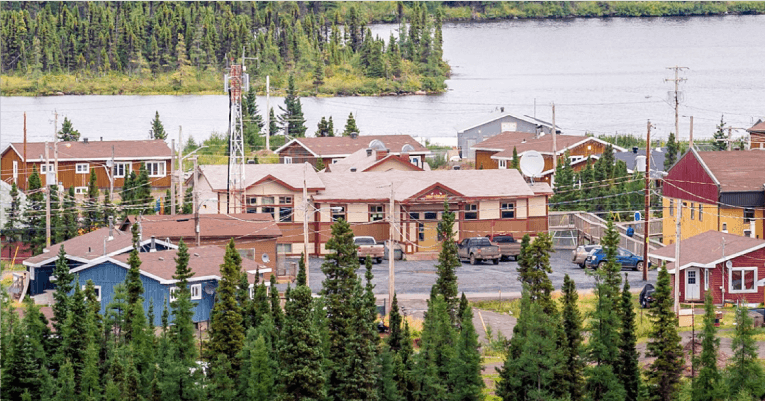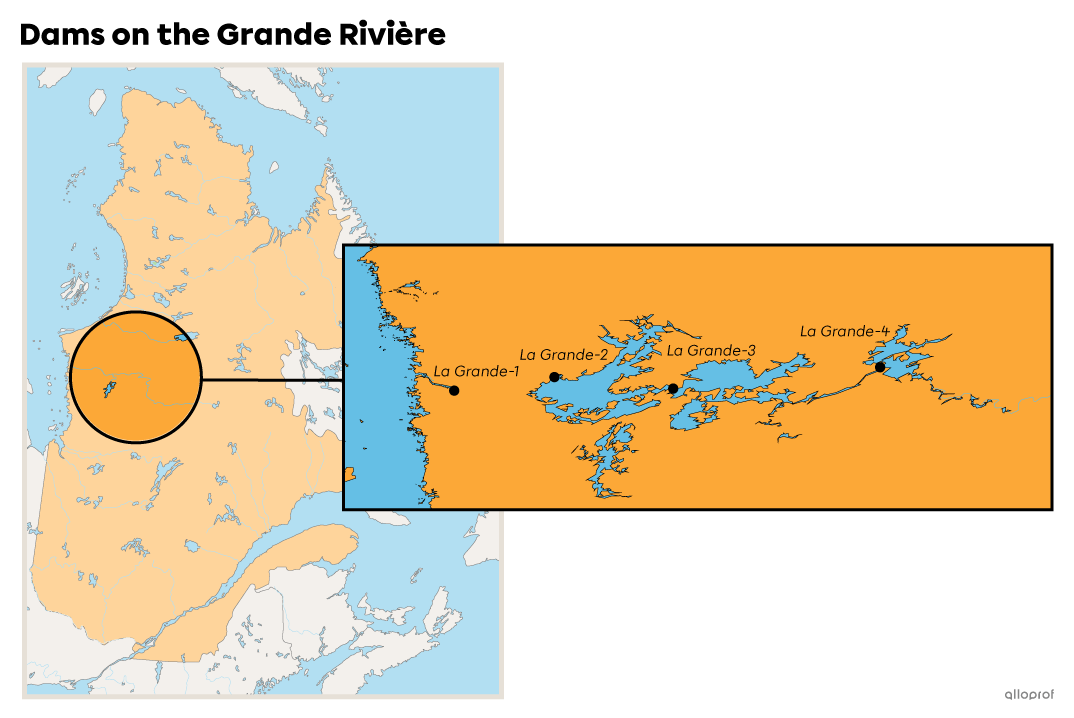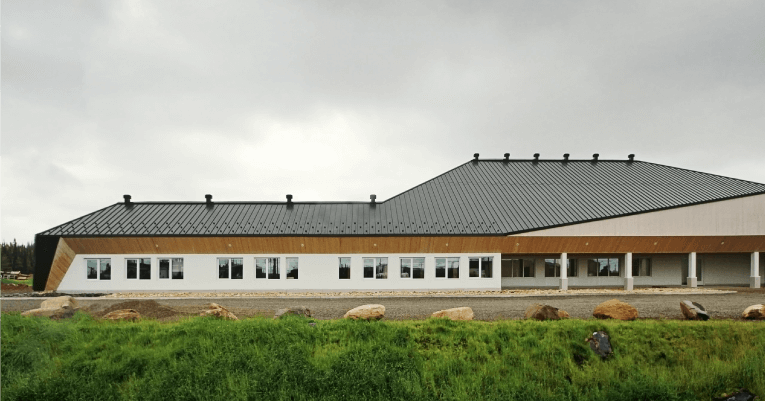To access the other concept sheets in the Indigenous Territory unit, check out the See Also section.
The Naskapi were once a nomadic people who lived primarily from hunting caribou. In the 1600s, they lived further north, close to present-day Kuujjuaq in Northern Quebec. In the early 1800s, they moved in order to be closer to a European trading post. By the mid-1900s, they moved closer to Schefferville where mining jobs were available. The village of Kawawachikamach was established in 1981, following the signing of the Northeastern Quebec Agreement in 1978. As of 2016, there were 601 people living in Kawawachikamach[1].
A nomad is a person who regularly travels from place to place to meet their food needs.
The only Naskapi territory in the world is located in Quebec. The community lives in the village of Kawawachikamach, in the administrative region of Côte-Nord. The lands there are reserved for the community which allows the Naskapi to practise their traditional activities. The Naskapi territory extends to the administrative region of Nord-du-Québec.

The Kawawachikamach territory is recognized by the governments of Quebec and Canada but does not represent the nation’s entire ancestral territory.
Source: Government of Canada, 2022[2]
Since the signing of the Northeastern Quebec Agreement, the Naskapi Development Corporation is in charge of the economic development of Kawawachikamach. Thanks to this organization, the village has, among other things, a primary and secondary school, a Naskapi-language radio station and a shopping centre.
The Corporation’s goal is also to preserve the Naskapi culture, traditions and language.

Source: Kawawachikamach [Photograph], Hood, A., n.d., SIL, (URL). All rights reserved*[3]
The region where the Naskapi village is located is only accessible by train or plane. The price of a plane ticket from Sept-Îles to Schefferville is very expensive, so most people take the train.
Since 2004, the Innu of Uashat mak Mani-Utenam and Matimekush-Lac John as well as the Naskapis of Kawawachikamach are the owners of the company Tshiuetin Rail Transportation Inc., which operates a railway between Sept-Îles and Schefferville via Labrador. They are the first Indigenous owners of a railway company in the history of Canada.
The development of this company is a source of pride for the Indigenous communities who own it.
If you would like to find out more, check out the article Schefferville train a vital link to life in Quebec's north.
In the early 1970s, the Quebec government began the construction of a hydroelectric project on the Grande Rivière. In the plans, a reservoir would be built on Naskapi ancestral land. This prompted the nation to start negotiations with the governments of Quebec and Canada.

These negotiations led to the signing of the Northeastern Quebec Agreement in 1978. Under this agreement, the Naskapi Nation obtained:
-
one territory of 41 km2 where the village of Kawawachikamach is located today
-
another territory of 326 km2 a few dozen kilometres to the north
-
exclusive hunting and fishing rights on a territory of more than 4 000 km2
-
financial compensation[4]
In exchange, the Naskapi renounced their territorial claims over their ancestral lands.
With the signing of the Northeastern Quebec Agreement, structures and resources were put in place for the Nation’s development. However, they are not sufficient.
The reality and the needs of the Naskapi community have changed in the 45 years since the signing of the Agreement. Some members of the community are currently questioning the Naskapi’s ability to make an informed decision at the time of the signing of the Agreement in 1978, when most Naskapi did not speak French or English and did not know how to read or write. The economic terms were probably not well understood, nor the true monetary value of the territory they were giving up. Consequently, members of the community are looking to renegotiate the Agreement.
In 1984, the Canadian government adopted the Cree-Naskapi (of Quebec) Act. This special law was a provision of the Northeastern Quebec Agreement and gave greater political autonomy to the Naskapi Nations to administer and manage their territories. This law replaced the Indian Act, except with respect to Indian Status.
In 2009, the Naskapi Nation of Kawawachikamach and the Quebec government signed the Partnership Agreement on Economic and Community Development Between the Naskapis and Quebec. The goal of this agreement was to promote the Nation's economic development and grant greater autonomy. Under the Agreement, Quebec committed to pay $73 million over a period of 25 years to the Naskapi community of Kawawachikamach[5].
The money was destined for the Nation’s economic and community development as well as invested in youth training and education. The band council intended to build an arena, among other things, in an effort to keep young people in the community.
This protocol was a response to the Naskapi community’s desire to review the agreement signed in 1978. Between early 2019 and early 2020, discussions were held between representatives of the Naskapi community and the Canadian government. The protocol established the basis for future negotiations between these two groups to ensure better recognition of Naskapi rights and greater self-determination (managing their own affairs).
The Cree, Inuit and Naskapi are three distinct peoples, each with their own culture. However, they face common challenges. The purpose of the Forum is to facilitate cooperation on ancestral rights and the rights under various treaties so that they can work together to increase their autonomy and improve their living conditions.
The Naskapi community has been taking steps for many years to ensure its economic development, including through the Naskapi Development Corporation.
The Naskapi territory has many resources, such as mining resources and rivers for hydroelectricity. There are projects to exploit these resources through the construction of mines or dams. This would provide workers in the community with access to more jobs and they would not have to leave their community to find employment elsewhere.
However, economic development often leads to pollution or damages the territory. This can endanger fauna and flora, which are sources of food for the community. The development of the territory brings up issues, specifically around protecting the land and respecting nature.
Economic development related to mining raises another issue because the mining industry is unstable and when mines close, for various reasons, members of the community lose their jobs.
Century, a mining company, has been planning to open an iron mine close to Lake Joyce, some 20 kilometres from Kawawachikamach for several years. It plans to extract 2.5 million tons of iron ore per year for seven years. It also plans to drain the lake while the mine is in operation to ensure worker safety.
The mining company held meetings and consultations with the Indigenous communities affected by the project, including the Naskapi, who plan to conduct a study on the impact of this project on the territory and Naskapi traditions before deciding whether or not to agree to the project.

Lake Joyce is located close to the village of Kawawachikamach. Many members of the Naskapi community go there to practice many activities such as hunting.
Source: Lake Joyce [Photograph], Century, (n.d.), (URL). Rights reserved*[6]
The Naskapi community’s village is only accessible by train or plane, making it relatively isolated. Despite this, the community has a number of services thanks to various initiatives and agreements. Among other things, there is a school, the only one to offer students Naskapi language immersion. There is also a CLSC (Local Community Services Centres) to provide care on site, which reduces the number of medical evacuations outside the community.
The Naskapi CLSC moved to a new building in 2018 to better respond to the community’s needs. However, in fall 2022, an inquiry revealed a number of problems, including difficult access to mental health services. The CLSC’s administration explained that the problems were due, in part, to staff shortages and committed to putting in place solutions to ensure proper care for the community.

Source: Naskapi CLSC [Photograph], Cecobois, (n.d.), (URL). Rights reserved*[7]
To access the rest of the unit, you can consult the following concept sheets.
- Statistics Canada. (2021, October 27). Census Profile, 2016 Census. Government of Canada. https://www12.statcan.gc.ca/census-recensement/2016/dp-pd/prof/details/page.cfm?Lang=E&Geo1=CSD&Code1=2497806&Geo2=PR&Code2=46&Data=Count&SearchText=Kawawachikamach&SearchType=Begins&SearchPR=01&B1=All&GeoLevel=PR&GeoCode=2497806&TABID=1
- Government of Canada. (2022, December 12). Aboriginal Lands of Canada Legislative Boundaries. https://open.canada.ca/data/en/dataset/522b07b9-78e2-4819-b736-ad9208eb1067
- Hood, A. (n.d.). Kawawachikamach [Photograph]. SIL. (URL).*
- Bernier Cormier, E., Goulet, G., Krysztofiak, V. and Ste-Marie, P. (2016). Chroniques du Québec et du Canada 1840 à nos jours — 4e secondaire [Student manual]. ERPI.
- Radio-Canada. (2009, October 15). Une entente sur 25 ans. https://ici.radio-canada.ca/nouvelle/450223/naskapis-quebec-entente
- Century. (n.d.). Lake Joyce [Photograph]. (URL).*
- Cecobois. (n.d.). Naskapi CLSC [Photograph]. (URL).*
*Content used by Alloprof in compliance with the Copyright Act in the context of fair use for educational purposes. [https://laws-lois.justice.gc.ca/eng/acts/c-42/page-9.html].